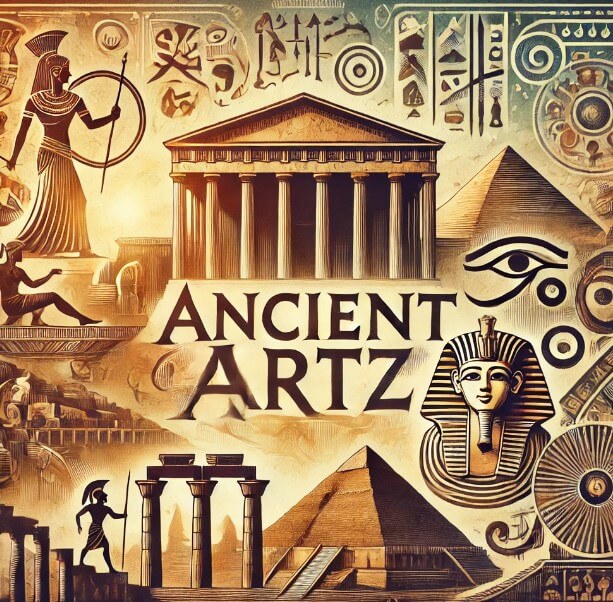Ancient Artz encompasses a vast and mesmerizing realm of human expression that stretches back thousands of years. From the delicate carvings of ancient Egypt to the monumental statues of Greece, ancient art provides a window into the beliefs, customs, and daily lives of early civilizations. This article will take you on a journey through the diverse styles, techniques, and cultural significance of Ancient Artz, revealing why these timeless works continue to captivate audiences today.
Origins and Evolution of Ancient Artz
What is Ancient Artz?
Ancient Artz refers to the artistic expressions created by early civilizations before the fall of the Western Roman Empire in 476 AD. It includes various art forms such as sculpture, painting, pottery, and architecture. These works often had religious, ceremonial, or functional purposes, and they reflect the cultural, social, and political values of their respective societies. .
Key Civilizations and Their Contributions
1. Ancient Egyptian Art
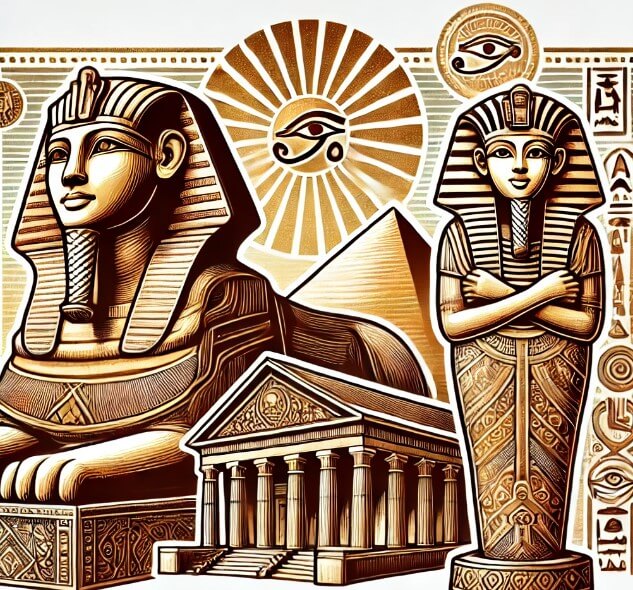
The art of ancient Egypt, one of the world’s oldest and most influential civilizations, has fascinated people for millennia. It is characterized by its symbolic, highly stylized forms, and its strict adherence to traditional rules.
- Sculpture and Monuments: Colossal statues like the Sphinx and monuments such as the pyramids are among the most iconic symbols of Egyptian art.
- Hieroglyphics: Artistic writing in the form of hieroglyphics adorned temples, tombs, and scrolls, serving both decorative and communicative purposes.
- Funerary Art: The elaborate burial practices, including the creation of detailed sarcophagi and paintings depicting the afterlife, highlight the Egyptian focus on the journey to the afterlife.
2. Mesopotamian Art
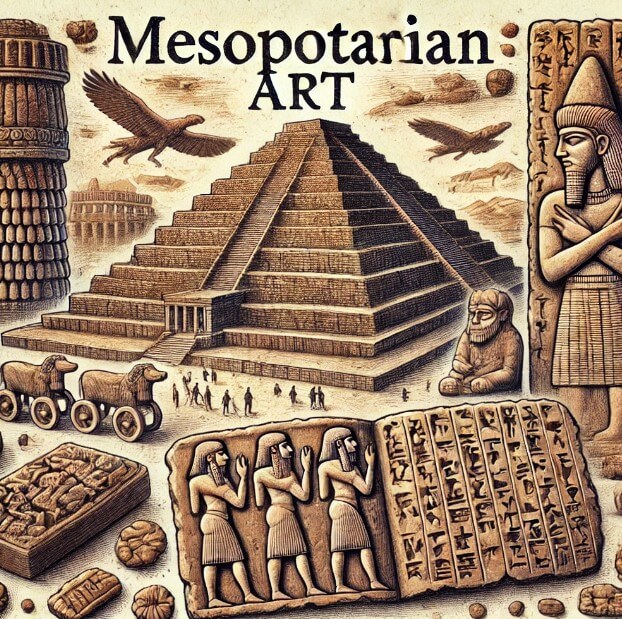
Located between the Tigris and Euphrates rivers, Mesopotamia gave rise to some of the earliest forms of art and architecture.
- Ziggurats: These massive stepped structures served as temples and were decorated with colorful tiles and reliefs.
- Relief Sculptures: Mesopotamian art includes bas-relief sculptures that depicted scenes of war, hunting, and religious rituals.
- Cylinder Seals: Small, intricately carved cylinders were used to stamp images onto clay tablets, functioning as signatures for documents.
3. Ancient Greek Art
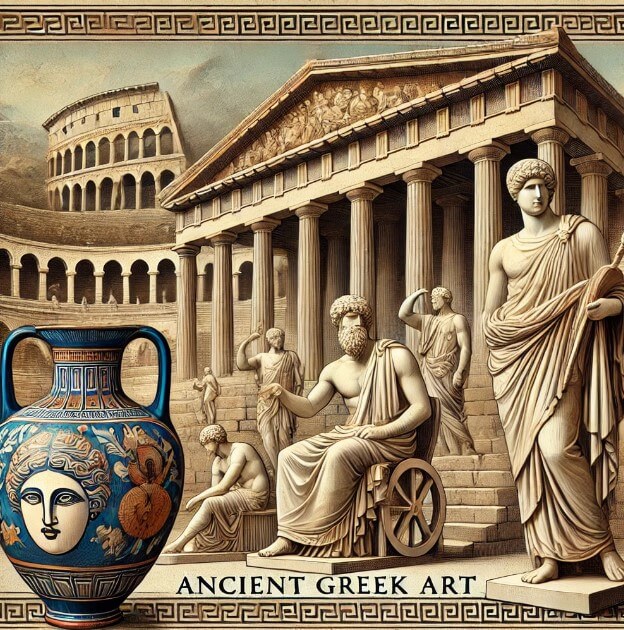
Greek art is celebrated for its emphasis on realism, balance, and the human form. It evolved over several periods, from the Archaic to the Hellenistic.
- Sculpture: Statues such as the Venus de Milo and the Discobolus (discus thrower) are famous for their detailed anatomy and lifelike quality.
- Pottery: Greek pottery often depicted scenes from mythology and daily life, using black-figure and red-figure techniques.
- Architecture: Structures like the Parthenon in Athens represent the Greeks’ mastery of proportion and architectural innovation.
4. Ancient Roman Art
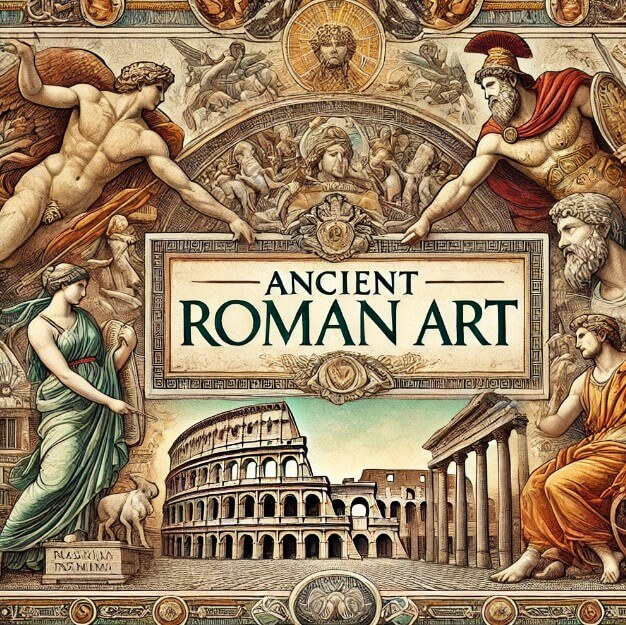
Roman art borrowed heavily from the Greeks but also introduced its own innovations, particularly in the realm of architecture and portraiture.
- Mosaics: Romans created intricate mosaics using small colored tiles to decorate floors and walls in homes and public buildings.
- Frescoes: Wall paintings depicting landscapes, mythological scenes, and daily life adorned the interiors of wealthy Roman homes.
- Engineering Marvels: The Romans built architectural wonders such as the Colosseum and aqueducts, which were not only functional but also artistically impressive.
5. Ancient Chinese Art
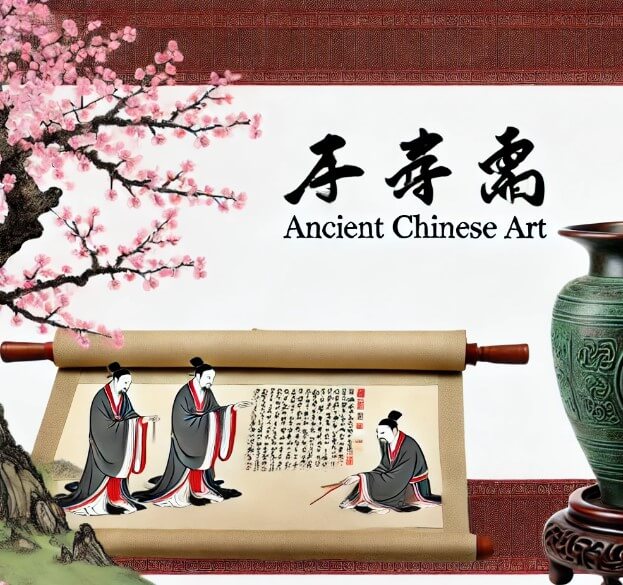
Chinese art has a long history marked by diverse forms, including calligraphy, pottery, and jade carving.
- Calligraphy: Considered one of the highest forms of art, Chinese calligraphy emphasized beauty in the form of written characters.
- Bronze Vessels: The Shang and Zhou dynasties produced elaborate bronze vessels for rituals, decorated with intricate patterns and inscriptions.
- Silk Paintings: Artists painted scenes of nature, mythology, and everyday life on silk scrolls, emphasizing harmony and balance.
Artistic Techniques and Materials
Sculpting Techniques
- Stone Carving: Sculptors of ancient times used basic tools made from metal and stone to carve statues and monuments. Techniques varied, from chiseling large figures to intricately detailing smaller sculptures.
- Lost-Wax Casting: This method was used to create bronze statues and involved making a wax model, encasing it in clay, and then melting the wax away to create a mold.
Painting Methods
- Fresco Painting: Popular in ancient Rome, frescoes were created by applying pigment onto wet plaster, allowing the colors to become part of the wall.
- Encaustic Painting: Used by the Egyptians in the Fayum mummy portraits, this technique involved mixing pigments with hot wax to create vivid, durable images.
Materials Used
| Material | Purpose |
|---|---|
| Stone (Limestone, Granite) | Used for building structures and carving statues |
| Bronze | Crafted into weapons, tools, and sculptures |
| Clay | Molding pottery and making bricks |
| Gold and Precious Metals | Jewelry, religious artifacts, and embellishments |
Symbolism and Religious Influence
Spiritual Beliefs in Art
- Ancient Egypt: Art was deeply tied to religion, with gods and goddesses depicted with specific symbols. For instance, Anubis, the god of the afterlife, was often shown with a jackal head.
- Mesopotamia: Deities and divine kings were frequently illustrated in art, emphasizing their power and connection to the heavens.
- Ancient Greece: The gods played a central role in Greek art, which depicted mythological stories to teach moral lessons or honor the deities.
Art as a Storyteller
Ancient Artz often served as a visual narrative of a civilization’s values, myths, and achievements. Temples, palaces, and even everyday objects were adorned with intricate details that conveyed important stories and cultural ideologies.
The Legacy of Ancient Artz
Influence on Modern Art and Architecture
The techniques and styles of Ancient Artz have had a lasting impact on modern art. From the Renaissance, which saw a revival of Greco-Roman ideals, to contemporary architecture inspired by classical forms, the influence of ancient art is undeniable.
Preservation Efforts
Today, historians and archaeologists work tirelessly to preserve ancient artworks and structures. Advances in technology, such as 3D scanning and digital reconstruction, have allowed us to study and protect these masterpieces for future generations.
Famous Artworks and Monuments
| Artwork/Monument | Civilization | Significance |
|---|---|---|
| The Great Sphinx | Ancient Egypt | Symbol of power and protection |
| The Ishtar Gate | Babylonian | Decorated with glazed tiles and animal reliefs |
| The Parthenon | Ancient Greece | Masterpiece of classical architecture |
| The Terracotta Army | Ancient China | Thousands of life-sized statues buried with Qin Shi Huang |
Conclusion
Ancient Artz represents humanity’s earliest attempts to capture the essence of life and the divine through various artistic mediums. It connects us to our ancestors, offering a glimpse into their world and the values they cherished. From the grand structures of Rome to the serene landscapes of Chinese paintings, ancient art is a reminder of the universal human desire to create and express.
FAQs About Ancient Artz
What defines Ancient Artz?
Ancient Artz refers to art created by early civilizations, typically up until the fall of the Western Roman Empire. It encompasses various forms, including sculpture, painting, and architecture, and often holds religious or ceremonial significance.
Why is Ancient Artz important today?
Ancient Artz is crucial for understanding the cultural and historical context of early societies. It provides insights into their religious beliefs, societal structures, and daily lives, shaping how we view the development of human civilization.
What materials were commonly used in Ancient Artz?
Common materials included stone, clay, bronze, gold, and pigments made from natural substances. These materials were chosen for their durability and availability.
How did Ancient Artz influence modern art?
Many modern art movements, such as the Renaissance, drew inspiration from ancient Greek and Roman art. Architectural styles, such as neoclassicism, also borrow heavily from ancient designs.
What are some famous examples of Ancient Artz?
Notable examples include the Pyramids of Giza, the Parthenon in Athens, the Ishtar Gate of Babylon, and the Terracotta Army in China. These works continue to be studied and admired for their craftsmanship and historical significance.
Are there ongoing efforts to preserve Ancient Artz?
Yes, archaeologists and preservationists use modern technology to protect and restore ancient art. Techniques like digital scanning and climate-controlled environments help ensure that these masterpieces remain intact for future generations.
Ancient Artz remains a captivating and enduring testament to the creativity and ingenuity of our ancestors, continuing to inspire awe and admiration across the globe.
Visit Magazeeno.com for more!

